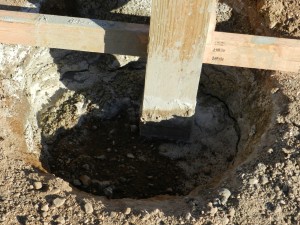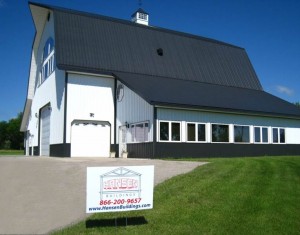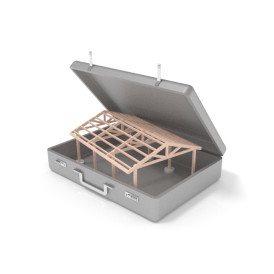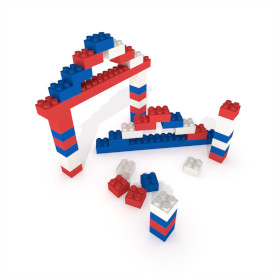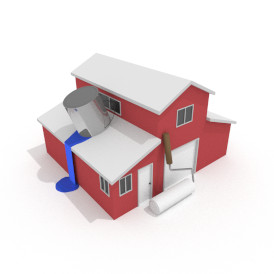I Simply Can’t Make the Numbers Work
 Reader and Registered Professional Engineer LILA in LaCENTER writes:
Reader and Registered Professional Engineer LILA in LaCENTER writes:
“Is it possible to build a 56×66 pole structure with 4.5×5.5 laminated posts, 10 feet tall at 12′ centers with 110 mph winds in zone C and in seismic zone D? I would dearly love to see the numbers on this since my client insists it can be done based on Hansen’s assurances. I simply can’t make the numbers work.”
It is always a pleasure to work with Registered Professional Engineers, who may not design post-frame buildings on a regular basis. Here are “the numbers”:
COLUMN CALCULATIONS
Sidewall Columns
The following calculations assume a 3-ply 2×6 glu-lam SYP 2400f.
Step 1: Calculate the roof diaphragm stiffness, ch
Aside from panel end fasteners, panel length is proportional to the number of fasteners when the pattern of sheet-to-purlin fasteners in the diaphragm is maintained for the predicted building diaphragm
C1: stiffness of test panel
C1 = 0.5 × P / Ds × a / b ASAE EP 484.1, Eqn. 4 referenced in Design of Commercial Post-Frame Buildings p.44
for a simple beam test where
P: panel strength
P = Pultimate × 0.4
Pultimate: ultimate panel strength
Pultimate = 6600 lbs Townsend, p.4
P = 6600 lbs × 0.4
P = 2640 lbs
Ds: deflection at P adjusted for sinking supports
Ds = 0.265″ Townsend, p.4
a: test panel frame spacing
a = 144″ Townsend, p.4
b: test panel length parallel-to-corrugations
b = 140″ Townsend, p.4
C1 = 0.5 × 2640 lbs / 0.265″ × 144″ / 140″
C1 = 5123.45 lbs/in.
The roof diaphragm stiffness of a gable roof comprised of two equal slopes, ch, is given by:
ch = 2 × C1 × (b’ / b) × (a / sf) × cos2θ (Design of Commercial Post Frame Buildings, p.44)
ch = 2 × 5123.45 lbs/in × (366.824″ / 140″) × (144″ / 144″) × cos2(18.435)
ch = 24163.786 lbs/in
Step 2: Calculate the frame stiffness, k
k: frame stiffness
k = 6 × E’ × I / (H12 × (0.7 × d + h)) Skaggs Eqn. 1
E: modulus of elasticity
E’ = E × Ci
Ci: incising factor
Ci = 1 NDS 4.3.8
E’ = 2000000 psi × 1
E’ = 2000000 psi
I: moment of inertia
I = 46.273 in.4
H1: Height of column above grade
H1: 120″
d: embedment depth
d = 30″
k = 6 × 2000000 psi × 46.273 in.4 / (120″2 × (0.7 × 30″ + 120″))
k = 273.479lbs/in.
Step 3: Calculate the potential lateral restraining force of the roof diaphragm, R
R: lateral restraining force
R = |sf × (H1′ × (qWW – qLW) × (2.8 × d + 3 × H1) / (8 × (0.7 × d + H1)) + H2 × (qWR – qLR))| Skaggs Eqn. 2
H1′: Height of column above grade that experiences wind pressure
H1′ = 120″
R = |144″ × (120″ × (7.53 psf – -13.325 psf) / 144 psi/psf × (2.8 × 30″ + 3 × 120″) / (8 × (0.7 × 30″ + 120″)) + 112″ × (-19.471 psf – -14.514 psf) / 144 psi/psf)|
R = 429.896 lbs
Step 4: Calculate the diaphragm factor, mD
mD: diaphragm factor
ratio of frame-to-roof stiffness = k / ch
ratio = 273.479 lbs/in. / 24163.786 lbs/in.
ratio = 0.011
# of frames = 7
mD = 0.95 Skaggs Table 1
Step 5: Calculate the shear at top of the windward post, V
V: shear at the top of post
V = 0.5 × (R × mD + sf × (h × (qWW + qLW) × (2.8 × d + 3 × h) / (8 × (0.7 × d + h))) – h2 × (qWR – qLR)) Skaggs Eqn. 3
V = 0.5 × (429.896 lbs × 0.95 + 144″ × (120″ × (7.53 psf + -13.325 psf) / 144 psi/psf × (2.8 × 30″ + 3 × 120″) / (8 × (0.7 × 30″ + 120″))) – 112″ × (-19.471 psf – -14.514 psf) / 144 psi/psf)
V = 344.904 lbs
Δ = V / k
Δ = 344.904 lbs / 273.479 lbs/inch
Δ = 1″
Step 6: Calculate the maximum post moments, M1 and M2
M1: moment at groundline
M1 = h × (V – ((sf × qWW × h) / 2)) Skaggs Eqn. 4
M1 = 120″ × (344.904 lbs – ((144″ × 7.53 psf / 144 psi/psf × 120″) / 2))
M1 = -12824.334 in.lbs
M2: moment above groundline
M2 = V2 / (2 × sf × qWW) Skaggs Eqn. 5
M2 = (344.904 lbs)2 / (2 × 144″ × 7.53 psf / 144 psi/psf)
M2 = 7899.459 in.lbs
Step 7: Calculate the axial compression force in post, Pf
Pf: compressive force post
Load Combinations (IBC):
1. D
Pf, D = sf × w / 2 × (roof dead load) + 0 × (H2 / (2 × w)) × (R × mD + sf × H2 × (qLR – qWR))
Pf, D = 144″ × 336″ × (15 psf / 144 psi/psf) + 0 lbs
Pf, D = 5040 lbs
2. D + S
Pf, D+S = sf × w / 2 × (roof dead load + roof snow load) + 0 × (H2 / (2 × w)) × (R × mD + sf × H2 × (qLR – qWR))
Pf, D+S = 144″ × 336″ × ((15 psf + 25 psf) / 144 psi/psf) + 0 lbs
Pf, D+S = 13440 lbs
3. D + W
Pf, D+W = sf × w / 2 × (roof dead load + (qWR – qLR)) + (H2 / (2 × w)) × (R × mD + sf × H2 × (qLR – qWR))
Pf, D+W = 144″ × 336″ × ((15 psf + (-19.471 psf – -14.514 psf)) / 144 psi/psf) + (112 / (2 × 672)) × (429.896 lbs × 0.95 + 144″ × 112″ ((-14.514 psf – -19.471 psf) / 144 psi/psf))
Pf, D+W = 3374.537 lbs
4. D + 0.75S + 0.75W
Pf, D+0.75S+0.75W = sf × w / 2 × (roof dead load + 0.75 × roof snow load + 0.75 × (qWR – qLR)) + 0.75 × (H2 / (2 × w)) × (R × mD + sf × H2 × (qLR – qWR))
Pf, D+0.75S+0.75W = 144″ × 336″ × ((15 psf + 0.75 × 25 psf + 0.75 × (-19.471 psf – -14.514 psf)) / 144 psi/psf) + 0.75 × (112 / (2 × 672)) × (429.896 lbs × 0.95 + 144″ × 112 ” ((-14.514 psf – -19.471 psf) / 144 psi/psf))
Pf, D+0.75S+0.75W = 10151.125 lbs
Step 8: Check post adequacy at groundline
CM: wet service factor
CM = 1 Column is protected from excessive moisture by building shell, concrete, or embedment
CD: load duration factor
CD = 1.6 NDS 2.3.2
Ci: incising factor
Ci = 1 NDS 4.3.8
CF: size factor
CF = 1 NDS Supplement
Ct: factor
Ct = 1 NDS 4.3
CP: column stability factor
CP = 1 NDS 3.7
Fc’: allowable compressive force post
Fc’ = Fc × CD × CM × Ct × CF × Ci × CP NDS 4.3
Fc’ = 1975 psi × 1.6 × 1 × 1 × 1 × 1 × 1
Fc’ = 3160 psi
CM = 1 Column is protected from excessive moisture by building shell, concrete, or embedment
Cr: repetitive member factor
Cr = 1 NDS 4.3
CF = 1 NDS Supplement
CL: beam stability factor
CL = 1 NDS 4.3
Cfu: flat use factor
Cfu = 1 NDS 4.3
Fb’: allowable bending stress post
Fb’ = Fb × CD × CM × Ct × CL × CF × Cfu × Ci × Cr NDS 4.3
Fb’ = 3000 psi × 1.6 × 1 × 1 × 1 × 1 × 1 × 1 × 1
Fb’ = 4800 psi
fc: axial compressive force post
fb: bending stress post
Load Combinations (IBC):
1. D
fc, D = Pf, D / (b × d)
fc, D = 5040 lbs / (21.141in2)
fc, D = 238.404 psi
fb, D = 0 × |M1| / S NDS 3.3.2
fb, D = 0 × |-12824.334 in.lbs| / 18.058 in3
fb, D = 0 psi
(fc, D / Fc’)2 + fb, D / Fb’ ≤ 1
(238.404 psi /3160psi)2 + 0 ≤ 1
0.006 ≤ 1
2. D + S
fc, D+S = Pf, D+S / (b × d)
fc, D+S = 13440 lbs / (21.141in2)
fc, D+S = 635.743 psi
fb, D+S = 0 × |M1| / S NDS 3.3.2
fb, D+S = 0 × |-12824.334 in.lbs| / 18.058 in3
fb, D+S = 0 psi
(fc, D+S / Fc’)2 + fb, D+S / Fb’ ≤ 1
(635.743 psi /3160psi)2 + 0 ≤ 1
0.04 ≤ 1
3. D + W
fc, D+W = Pf, D+W / (b × d)
fc, D+W = 3374.537 lbs / (21.141in2)
fc, D+W = 159.623 psi
fb, D+W = |M1| / S NDS 3.3.2
fb, D+W = |-12824.334 in.lbs| / 18.058 in3
fb, D+W = 710.19 psi
(fc, D+W / Fc’)2 + fb, D+W / Fb’ ≤ 1
(159.623 psi /3160psi)2 + 710.19 psi / 4800 psi ≤ 1
0.151 ≤ 1
4. D + 0.75S + 0.75W
fc, D+0.75S+0.75W = Pf, D+0.75S+0.75W / (b × d)
fc, D+0.75S+0.75W = 10151.125 lbs / (21.141in2)
fc, D+0.75S+0.75W = 480.171 psi
fb, D+0.75S+0.75W = 0.75 × |M1| / S NDS 3.3.2
fb, D+0.75S+0.75W = 0.75 × |-12824.334 in.lbs| / 18.058 in3
fb, D+0.75S+0.75W = 532.642 psi
(fc, D+0.75S+0.75W / Fc’)2 + fb, D+0.75S+0.75W / Fb’ ≤ 1
(480.171 psi /3160psi)2 + 532.642 psi / 4800 psi ≤ 1
0.134 ≤ 1
Column stressed to a maximum of 15.1%
Step 9: Check post adequacy at positive moment region
Fc’ = Fc* × CP NDS 4.3
CP: column stability factor
CP = (1 + (FcE / Fc*)) / (2 × c) – √(((1 + (FcE / Fc*)) / (2 × c))2 – (FcE / Fc*) / c) NDS 3.7.1
FcE = 0.822 × Emin’ / (le / d)2
Ke = 0.8 NDS 3.7.1
le = Ke × h NDS 3.7
le = 0.8 × 24″
le = 19.2″
FcE = 0.822 × 1020000 psi / (19.2″ / 5.125″)2
FcE = 59738.907 psi
CP = (1 + (59738.907 psi / 3160 psi)) / (2 × 0.9) – √(((1 + (59738.907 psi / 3160 psi)) / (2 × 0.9))2 – (59738.907 psi / 3160) / 0.9)
CP = 0.994
Fc’ = 3160 psi × 0.994
Fc’ = 3142.551 psi
fb: bending stress post
Load Combinations (IBC):
1. D
fb , D = 0 × M2 / S
fb , D = 0 × 7899.459 in.lbs / 18.058 in3
fb , D = 0 psi
(fc, D / Fc’)2 + fb, D / Fb’ ≤ 1
(238.404 psi /3142.551psi)2 + 0 ≤ 1
0.006 ≤ 1
2. D + S
fb, D+S = 0 × M2 / S
fb, D+S = 0 × 7899.459 in.lbs / 18.058 in3
fb, D+S = 0 psi
(fc, D+S / Fc’)2 + fb, D+S / Fb’ ≤ 1
(635.743 psi /3142.551psi)2 + 0 ≤ 1
0.041 ≤ 1
3. D + W
fb, D+W = M2 / S
fb, D+W = 7899.459 in.lbs / 18.058 in3
fb, D+W = 437.459 psi
(fc, D+W / Fc’)2 + fb, D+W /(Fb’ × (1 – fc, D+W / FcE)) ≤ 1
(159.623 psi /3142.551psi)2 + 437.459 psi / 4800 psi × (1 – 159.623 psi / 59738.907 psi)) ≤ 1
0.094 ≤ 1
4. D + 0.75W + 0.75S
fb, D+0.75S+0.75W = 0.75 × M2 / S
fb, D+0.75S+0.75W = 0.75 × 7899.459 in.lbs / 18.058 in3
fb, D+0.75S+0.75W = 328.094 psi
(fc, D+0.75S+0.75W / Fc’)2 + fb, D+0.75S+0.75W / Fb’ × (1 – fc, 0.75wind / FcE)) ≤ 1
(480.171 psi /3142.551psi)2 + 328.094 psi / 4800 psi × (1 – 480.171 psi / 59738.907 psi)) ≤ 1
0.092 ≤ 1
Column stressed to a maximum of 9.4%
∴ A 3-ply 2×6 glu-lam SYP 2400f column is adequate.
